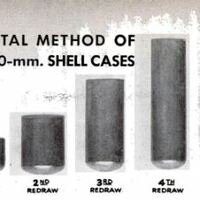Brass and Heat Make Cartridge Cases
Item
-
Title (Dublin Core)
-
Brass and Heat Make Cartridge Cases
-
Article Title and/or Image Caption (Dublin Core)
-
Brass and Heat Make Cartridge Cases
-
extracted text (Extract Text)
-
BRASS plus heat—that is the recipe
for the cartridge and shell cases
that translate American fighting
spirit into language that the Axis
powers can understand.
In a typical Eastern plant con-
verted to all-out war production,
electric furnaces produce millions of
pounds of the ammunition alloy each
month, by melting together 69 per-
cent of copper and 31 percent of zinc.
Preparing the metal requires more
processing than the actual manu-
facture of the cases, but both require
special heat treatment at almost
every operation.
Brass castings weighing hundreds
of pounds apiece get their first flat-
tening in breakdown mills, and
further rolling in an intermediate or
run-down mill, finally being formed
into cylindrical coils of the sheet
metal ready for cutting.
Now, powerful hy-
draulic presses go to
work on trimmed
“blanks” or disks cut
from the metal. A punch
forces the brass into the
cavity of a die, first
forming a shallow thim-
ble. In successive opera-
tions, the step is repeat-
ed, forming a deeper
cylinder each time. Final-
ly, finishing operations
form the shoulder and
neck; the case is headed
and indented; and identi-
fication numerals and letters are stamped
on. At the top of these pages, the stages in
forming 20-mm. cartridge cases are shown.
Automatic cannon or super-machine guns
using this type of ammunition are employed
principally on fighter aircraft. Others of
the fifteen different sizes of cases made at
the plant range up to five-inch size. For
cases of all sizes, the manufacturing process
is basically the same.
-
Language (Dublin Core)
-
eng
-
Date Issued (Dublin Core)
-
1942-08
-
pages (Bibliographic Ontology)
-
42-43
-
Rights (Dublin Core)
-
Public Domain (Google Digitized)
-
Archived by (Dublin Core)
-
Roberto Meneghetti
-
Marco Bortolami (editor)
 Popular Science Monthly, v. 141, n. 2, 1942
Popular Science Monthly, v. 141, n. 2, 1942
 Cattura.JPG
Cattura.JPG
